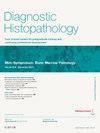如何区分反应性和肿瘤性扁平尿道病变
引用次数: 0
摘要
扁平尿道病变很常见,识别扁平尿道病变对患者的治疗非常重要。过度治疗或治疗不当都可能导致误诊。报告正确的诊断对后续治疗也很重要。我们描述了最常见的病变,并重点介绍了其临床意义。所描述的病变中有几种并不在世界卫生组织 2022 年的分类中,因此了解这些病变非常重要。我们还讨论了良性病变、前驱病变和恶性病变,并推荐了国际学会给出的最新命名。在可能的情况下,我们还纳入了目前已知的分子数据。我们的目的是为这一复杂的课题提供一个实用而准确的概述。本文章由计算机程序翻译,如有差异,请以英文原文为准。
How to distinguish between reactive and neoplastic flat urothelial lesions
Flat urothelial lesions are common and recognition is important for patient management. Over- and undertreatment can be a consequence of misdiagnosis. Reporting the right diagnosis is also important for the follow-up. We describe the most frequent entities with a focus on clinical meaning. Several of these described lesions do not figure in the WHO 2022 classification; therefore knowledge of them is important. We also discuss benign, precursor and malignant lesions and suggest the latest nomenclatures given by international societies. Molecular data, as far as currently known, are included where possible. The aim is to give a practical and precise overview of this complicated topic.
求助全文
通过发布文献求助,成功后即可免费获取论文全文。
去求助
来源期刊

Diagnostic Histopathology
Medicine-Pathology and Forensic Medicine
CiteScore
1.30
自引率
0.00%
发文量
64
期刊介绍:
This monthly review journal aims to provide the practising diagnostic pathologist and trainee pathologist with up-to-date reviews on histopathology and cytology and related technical advances. Each issue contains invited articles on a variety of topics from experts in the field and includes a mini-symposium exploring one subject in greater depth. Articles consist of system-based, disease-based reviews and advances in technology. They update the readers on day-to-day diagnostic work and keep them informed of important new developments. An additional feature is the short section devoted to hypotheses; these have been refereed. There is also a correspondence section.
 求助内容:
求助内容: 应助结果提醒方式:
应助结果提醒方式:


